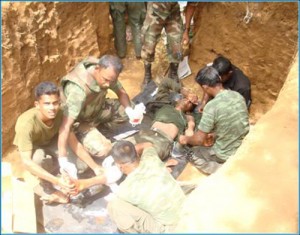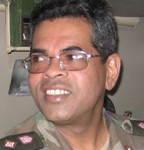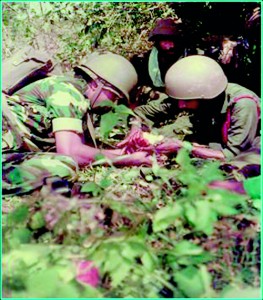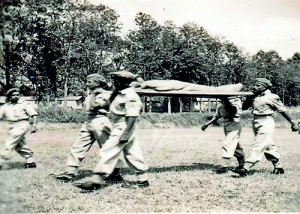Silent saviours

Waging their own war: Medical Corps personnel in trenches (above) and (top right) in the jungle saving their fallen colleagues
Dropped from a chopper onto the bund of a wewa, the battle scene was not good. He knew his Malli’s unit had been fighting within the thick jungles just beyond. His younger brother’s buddy looked out of the tent but could not meet his eyes.
He feared the worst but got down to his job, attending to the numerous casualties being carried out of the jungle. His brother was dead at the hands of the Liberation Tigers of Tamil Eelam (LTTE), having laid down his life in defence of the sovereignty of his motherland.
But for heavy-hearted Captain Sanjeewa Munasinghe, this was not the time to grieve, that would come later. Just as his brother had done his duty until the last breath left his body, in a small operation at Veppankulam, he too had to get on with the job of treating the battle-wounded.
Into the night as he went about his task with his team, there came several injured Tigers. No hesitation stilled his hand, no hatred engulfed his being, his duty was to treat the injured, be it friend, foe or civilian, and that is exactly what he did.
This was just before Operation Greenbelt and though he was due to be part of that, having heard of the smaller operation he had volunteered for this job.
The date: March 30, 1991. The battle arena: Mannar.

Maj. Gen. Munasinghe
Now Colonel Commandant of the Sri Lanka Army Medical Corps., and Director-General of the Army Health Service, Major General (Dr.) Sanjeewa Munasinghe insists that this piece should not be about him but about each and everyone on his selfless team. His experiences, however, encapsulate in full measure what the army medics have been performing silently “behind the scenes” but at the battlefront amidst the battas (anti-personnel mines), the snipers, the blood, the injured and the dead.
‘Faithful in distress’ they have been, true to their motto, amidst the thick of fighting, with the Sinhala slogan ‘Vipathedi Pihita’ being more evocative.
Five years to this day (May 18) after the 30-year war ended, the memories flow of the numerous operations when he and his team were very much a part of the frontline troops. The early times in the 1980s and ’90s when suddenly the Sri Lanka Army was faced with the biggest threat to the country since Independence, the army medics would take the necessities in their backpacks, trudging for miles in trying terrain.
Streamlining and massive improvements in service delivery came about in the 2000s.
The beginnings, however, were humble, very humble. It had been Major Todd Hill, a Surgeon in the British Royal Army with eight medical students from then Ceylon who launched the Stretcher Bearer Company attached to 2 Ceylon Light Infantry Volunteers way back on July 29, 1881. (See box for its evolution)
In more modern times, it was in December 1986 that Major General Munasinghe joined the regular army as a young Medical Officer (MO), the 14th to do so up to that time. The first military operation when an MO accompanied troops was on February 2, 1987.
The operation was launched from Yakawewa, about four km from Medawachchiya. Dropped off by tractor around 4 a.m. he marched with 3 Sri Lanka Light Infantry under Commanding Officer (CO) Lt. Col. Narada Wickremaratne and second-in-command, Major Nanda Mallawarachchi.
They marched along the road and through the jungles of Adampan, with the first casualty being Lt. Ralph Nugera who was caught in a mortar attack and had shrapnel in his body which the medics removed, dressing the wound and giving him antibiotics to ward off infection.
 “We carried all the medications and saline in our backpacks,” recalls Maj.Gen. Munasinghe who along with his team of three male nurses and about five orderlies were on the move with the troops for nearly three months, hopping on a chopper at Jayapura to get home just in time for the Sinhala New Year.
“We carried all the medications and saline in our backpacks,” recalls Maj.Gen. Munasinghe who along with his team of three male nurses and about five orderlies were on the move with the troops for nearly three months, hopping on a chopper at Jayapura to get home just in time for the Sinhala New Year.
“Many a time we came under attack, attending to the casualties while under fire,” he says.
After the New Year, it was Operation Liberation, the first-ever major operation carried out by the army. Along with the troops went three MOs – Capt. S.D.C. de Silva, Capt. J.B. Liyanage and himself.
Vivid are the battle memories of this operation launched on three fronts from Palali, Jaffna Fort and Thondamannar, experiencing numerous booby-traps along the way and the deadly battas for the first time. The casualty numbers were fewer than 200 with about 29 deaths.
Soon after returning to Colombo, while in the mess, when news reached them that the Neliaddy school that the army had liberated was under attack, he immediately volunteered to go there, being dropped by a chopper amidst intense firing, treating the injured for two days.
Thereafter, in a short respite, it was peacetime, with the Indian Peace Keeping Force (IPKF) coming to Sri Lanka, as Maj. Gen. Munasinghe and his team watched from Palali.
It was, however, a temporary peace, with the shameful killing of hundreds of policemen in the east, plummeting the country into Eelam War II in 1990.
It was then that Maj. Gen. Munasinghe and his team flew east. His brother was cornered in a camp at Kiran in 1990, facing gas, mortar and small-arm attacks by the Tigers. On the radio-set, Maj. Gen. Munasinghe would tell them to wet their uniforms and hold them against their faces. There was no water and his solution was saliva. He would also give istructions how to handle the casualties.
This veteran Medical Corps officer’s mind goes back to a major Special Forces operation in the thick jungles of  Kandikudichchuaru.“Unique” it was because all the armaments were taken not in a vehicle but a bullock cart. Two and a half weeks they were in the jungle with no chance of evacuation of the injured (it came only eight long days later) as helicopters could not land in the jungle.
Kandikudichchuaru.“Unique” it was because all the armaments were taken not in a vehicle but a bullock cart. Two and a half weeks they were in the jungle with no chance of evacuation of the injured (it came only eight long days later) as helicopters could not land in the jungle.
Amputations were done in the field and the wounded with saline and antibiotic drips carried by his dedicated men, though shortstaffed, who never gave in to tiredness.
Making-do under trying circumstances was their forte – when a soldier’s chest had to be drained, as carrying bottles to the field to gather the outflow was difficult, the draining tube would be attached to a condom in which holes were pricked. When a blood vessel was injured, to maintain patency, a saline tube would be made the temporary conduit.
Wanni Wickram 1, 2, 3; Akunu Pahara (attack on 14 base of Tiger leader Velupillai Prabhakaran) which was launched from Gajabapura close to Weli Oya; Operation Balavegaya (breaking through to the besieged Elephant Pass camp not once but twice, the former after a beach-landing); and much more the Medical Corps has been an integral part of.
The largest number of amputees due to batta blasts was in Operation Akunu Pahara, says Maj. Gen. Munasignhe, reliving those days when their first act would be to put the soldiers out of their pain by giving them ketamin, a deep sedative.
During Operation Balavegaya, when he was asked to take 10 men and get into the Elephant Pass camp and bring out the injured so that those in the camp could defend it more effectively, he had attempted to relieve those of his men who were married and had children from this duty. But when told, all of his 15 men, had stood as one to make the foray into the beleaguered camp and help their brother soldiers. In there, literally holding the fort with regard to casualty matters had been, Estate Medical Assistant, Sisira Godamune of the Medical Corps.
Narrow shaves have also been numerous – one says it all. In a battle that had erupted near Kokkuthudai close to Weli Oya, the advance party which had set off at 5.30 a.m. had been decimated. With Maj. Gen Munaisnghe and his buddy being dropped near the lagoon, the firing had been intense. Two soldiers of the decimated group seeing their arrival had begun running towards them when the pair shouted “down, down” as they were easy targets. One had been hit and killed but the other soldier had managed to crawl up to them with a serious neck injury, a bullet having passed from one side of the jaw across to the other. Isolated but hidden by the bushes, while the support company coming to the aid of the soldiers thinking that the three of them had been taken prisoner, Maj. Gen. Munasinghe had put a tube into the throat of the soldier to allow him to breathe, a life-saving measure, with his buddy atop of the victim holding him down…..all the while the relentless firing continuing around them.
By the time 1995 came with Operation Riviresa the backpack system of carrying medicines had changed. Every battalion (500-600 soldiers) had a Medical Corps team which accompanied it to the front by tractor or armoured tank while at brigade-level there was an Advanced Dressing Station in a tent with an MO or Registered Medical Officer who with a team performed emergency and life-saving measures such as minor surgery With an ambulance on standby, they would then transfer the injured soldiers to the Main Dressing Station at Divisional Headquarters, still located in the field but away from mortar range. Here there would be a bigger Medical Corps team headed by an MO and about 16 members. Except for head and abdominal injuries which could only be supported by therapy and making the patient stable, everything else could be handled here such as chest and limb injuries. The casualties could also be anaesthetised here or put on a portable ventilator.
From the Main Dressing Room, the injured soldier would be airlifted to the nearest army base or field hospital or civil hospital. Depending on the injuries suffered, next would be the Army Hospital in Colombo or the civil hospitals such as the National Hospital, Sri Jayewardenepura, Ragama or Kalubowila.
Operations Sath Jaya, Edi Bala, Jayasikuru and the Humanitarian Operation from July 2006 to May 18, 2009 followed.
“The Humanitarian Operation was the largest we faced when we take the number of troops involved and the land area involved,” says Maj. Gen. Munasinghe. We faced the challenge with limited resources – at the start of the op there were only 61 MOs and about 1,500 nurses and nursing assistants.
The Medical Corps also appreciates the unstinting support of the Health Ministry and civilian doctors who willingly lent a hand whenever the need arose.
The role of the Medical Corps begins during the recruitment of soldiers, explains the CO of the Army Hospital Lt. Col. Nishantha Pathirana, pointing out, “We pick the candidates suitable for the army after a thorough medical screening. Its role continues throughout – before the promotion of anyone within the army, before anyone departs for overseas training, before any punishment is meted out and even before retirement. The army cooks and food-handlers also undergo regular medical check-ups to ensure they are free from infection.
“We not only take responsibility for the mental and physical health of the soldier but we also take the responsibility of looking after his family so that he is free to do his job of fighting for his country,” says Maj. Gen. Munasinghe, adding that when injured or disabled the Medical Corps is always by the soldier’s side. When a soldier dies on duty, we continue to look after his family while in retirement we look after the old soldiers.
Starting tomorrow the Medical Corps will screen everyone over 30 in the army for risk factors such as hypertension, diabetes and cholesterol for non-communicable diseases.
In natural and man-made disasters we are the first responders, points out Maj. Gen. Munasinghe, citing a few examples of the major floods in Ratnapura which had a ripple effect, the earthslips at Kalawana and the devastating tsunami of 2004 as well as the massive bomb blasts at the Central Bank, the CTO, the Galadari Hotel and Maradana.
“We are there until the Health Ministry takes over,” he says, adding that the services of the Medical Corps, extend way beyond the battlefields. It also safeguards the health of VIPs and VVIPs and any foreign delegate who visits Sri Lanka. Even with UN Peace Keeping Missions, members of the Medical Corps have a presence in Haiti, Lebanon and Sudan.
Back in the 1960s they had been part of the Congo mission, the Sunday Times learns.
Along with the Health Ministry we provide medical services at national and international sports events, says Lt. Col. Pathirana.
With one officer and 58 other rankers laying down their lives in the Humanitarian Operation and 50 gallantry awards being shared among those in the Medical Corps., two being the Rana Wickrema Padakkama and Rana Sura Padakkama honouring Maj. Gen. Munasinghe their indispensable role is undisputable.
Having done their duty to the hilt during World Wars I and II, the insurgencies of 1971 and 1988 and the 30-year Eelam War, the Medical Corps is well and truly the lifeline of the Sri lanka Army.
| How the Medical Corps evolved- 1911 – The Stretcher Bearer Company becomes an independent battalion, the Ceylon Medical Corps. - 1918 – Renamed the Ceylon Army Medical Corps.  - 1949 – Soon after Sri Lanka gained independence, the first regular battalion, 1st Battalion of Ceylon Army Medical Corps formed on October 21 with four officers and 20 other rankers. The first Commanding Officer is Major H.C. Serasinghe. - 1950 – A 10-bed Medical Reception Station (MRS) set up at the British Military Hospital at Galle Face. - 1952 – MRS upgraded to a 50-bed Service Hospital. - 1961 – MRS set up at Diyatalawa Army Training Centre. - 1972 – Ceylon Army Medical Corps has a name-change to Sri Lanka Army Medical Corps. - 1983 – Two army base hospitals set up at Palali in Jaffna and Panagoda. - 1997 – The Anuradhapura army base hospital is established. - 1985 – Directorate of Army Medical Service established to coordinate and supervise technical matters relating to the treatment of patients. - 1988 – Bed capacity of Army Hospital expands to 410 - 1990 – With the army being restructured and the regimental concept being introduced, in addition to the Directorate, the Regiment of Sri Lanka Army Medical Corps to administer persons in battalions is launched. The first Regimental Commander is Brigadier C. Thurairajah. - 1999 – Third Battalion of Medical Corps established at Anuradhapura in the midst of the war; followed by the Fourth Battalion in Jaffna in 2007; and the Fifth Battalion at Habarana in 2010. More than a supportive arm The Medical Corps partner in all welfare activity is its Seva Vanitha Unit headed by Brigadier Dilrukshi Munasinghe not only the wife of Maj. Gen. Munasinghe but in her own right an army officer and Consultant Radiologist. It’s the Seva Vanitha Unit which looks after the welfare of the families of deceased Medical Corps members as well as their children’s education. The unit also supports the educational needs of the children of other members and has established the Army Medics Student Support Fund. It is also a part of the mobile clinics that go to the outstations to provide medical help to both army families and civilians. |


